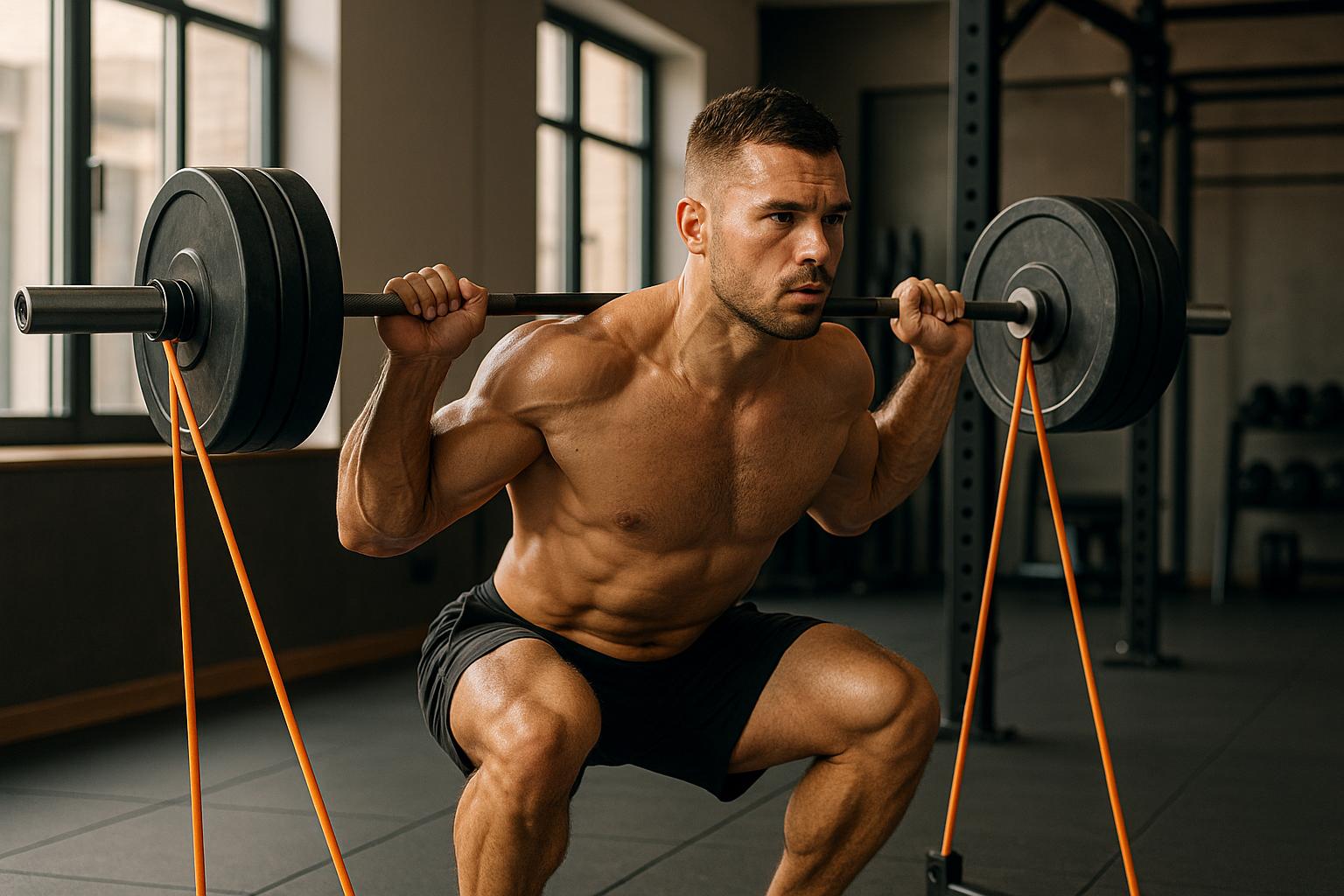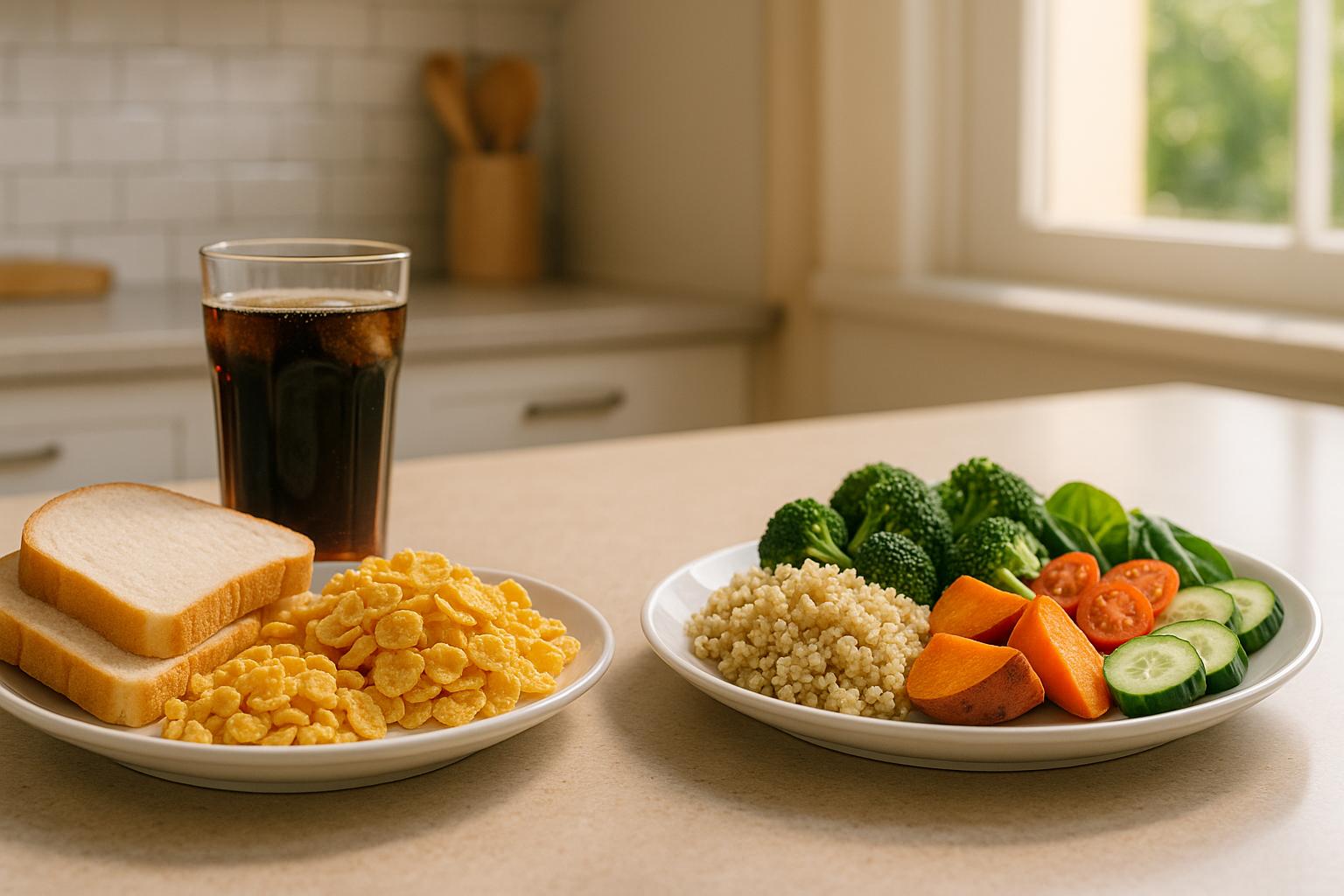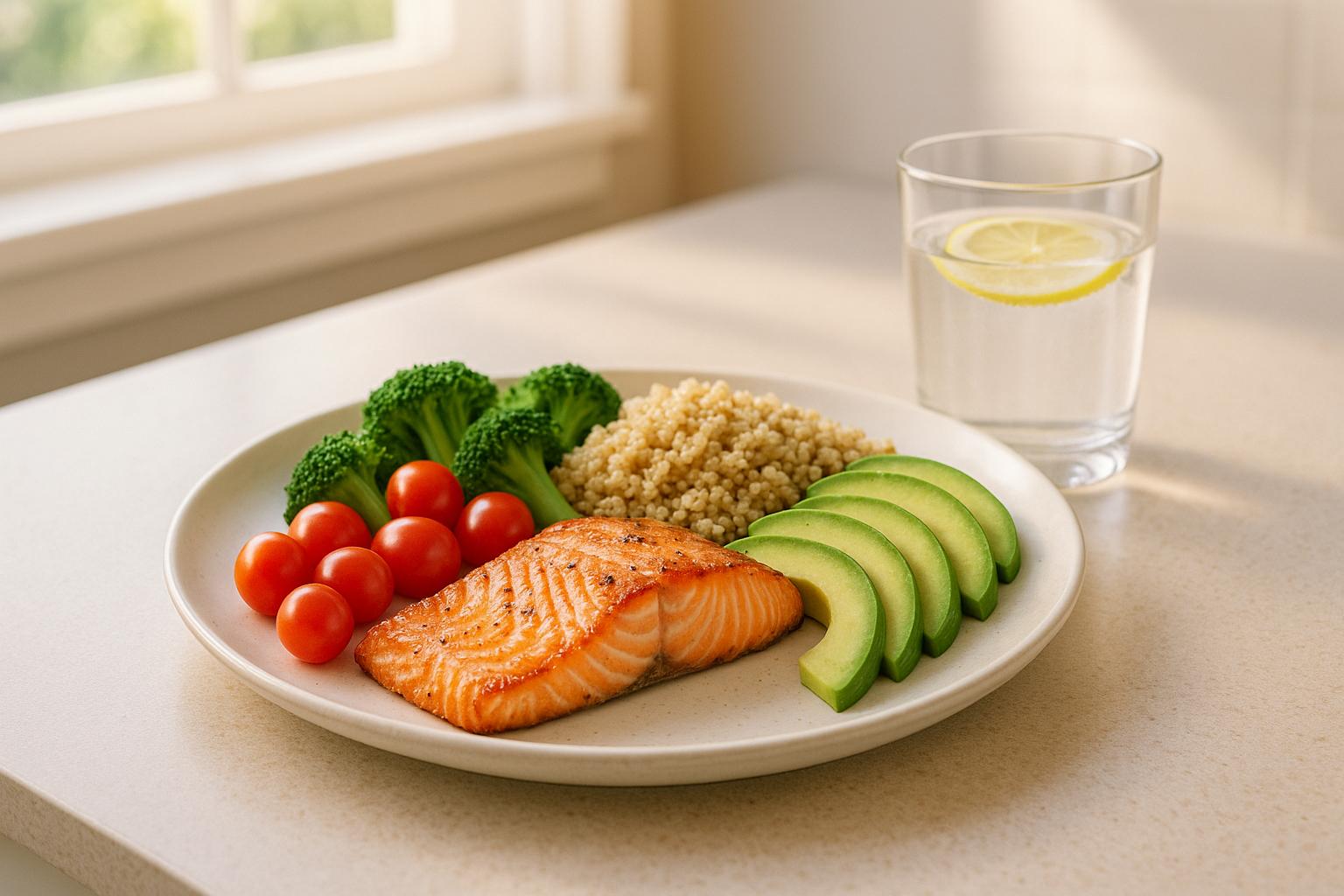Variable Resistance Training (VRT) adjusts resistance throughout a movement, aligning with your body's natural strength curve. This method uses bands, chains, or specialized equipment to increase resistance where you're strongest and decrease it where you're weakest. It works hand-in-hand with progressive overload, a principle that involves gradually increasing training demands to build strength and muscle. Here's what you need to know:
- What is VRT? A strength training method that dynamically changes resistance during exercises.
- How does it work? It challenges muscles across the full range of motion, avoiding plateaus and reducing joint stress.
- Key benefits: Improved strength, better muscle engagement, and enhanced neuromuscular efficiency.
- Who benefits? Beginners gain more with lighter loads, while experienced lifters see results with heavier resistance.
- Limitations: Requires specific equipment, and tracking progress can be complex.
VRT is an effective option for breaking through training plateaus and improving overall strength by tailoring resistance to your body's capabilities.
Scientific Foundations of Progressive Overload in VRT
How Muscles Adapt and Grow
The principle of progressive overload is at the core of why Variable Resistance Training (VRT) works so well. When you push your muscles with gradually increasing demands, your body responds with adaptations on both a cellular and systemic level.
Muscle growth, or hypertrophy, starts with tiny tears in muscle fibers, which trigger inflammation and activate the mTOR pathway. However, a 2018 study suggests that muscle damage might not be the main driver of hypertrophy. Instead, metabolic stress plays a larger role. For example, maintaining continuous tension on muscles can create moderate hypoxia, which has been shown to increase growth hormone levels and stimulate muscle growth.
Progressive overload also improves neuromuscular efficiency. This means your muscles and nervous system work better together, enhancing coordination and force production. Interestingly, this explains why strength improvements often happen before you see noticeable muscle growth.
Hormones are another piece of the puzzle. Increased levels of testosterone and growth hormone during training further support these adaptations. The type of exercise you choose matters, too. For instance, one study found that squats were far more effective than leg presses at boosting growth hormone levels - even when the same weight was used.
These biological processes give VRT its edge, helping explain the impressive results seen in recent research.
Research on Variable Resistance Methods
Scientific studies back up the role of progressive overload in VRT. When compared to traditional resistance training, research shows that VRT can deliver unique benefits, though results often depend on factors like training experience and load selection. A meta-analysis of 14 studies found that VRT led to significantly greater improvements in maximum strength, with an effect size of 0.80.
For trained individuals, VRT showed a moderate effect size of 0.57, with loads at or above 80% of their one-repetition maximum (1RM) producing the best strength gains. For beginners, the results were even more striking. Using lighter VRT loads - below 80% of 1RM - led to an effect size of 2.38 in maximum strength gains.
That said, not all research paints VRT as universally superior. A meta-analysis of 17 studies involving 491 participants found no significant difference between VRT and traditional resistance training in improving maximum muscle strength for either the upper or lower body. As Vidar Andersen et al. noted, "Our results suggest that variable resistance training and traditional resistance training are equally effective in improving maximal muscle strength and muscle power in healthy adults."
When it comes to building muscle mass, a systematic review of 12 studies found no clear advantage for VRT over traditional training in short- to medium-term programs for untrained individuals.
These findings highlight the importance of examining factors like load, range of motion, and tempo to understand how VRT optimizes training.
Impact of Load, Range of Motion, and Tempo
One of the standout features of VRT is how it addresses a common limitation in traditional weightlifting. Research shows that strength varies significantly between the weaker and stronger parts of a movement, meaning the weight you're lifting often doesn’t match your muscles' potential throughout the exercise.
With VRT, load manipulation aligns with your body's natural strength curve, making muscles work harder when they’re at their strongest. This involves three critical elements: force variance, diminishing range, and constant tension.
Range of motion is another key factor. In traditional lifting, a significant portion of the movement involves deceleration. For example, during a bench press at 80% of 1RM, about 52% of the upward movement is spent slowing the barbell down. Even with lighter loads at 45% 1RM, deceleration accounts for around 40% of the lift.
VRT solves this issue by maintaining tension throughout the entire range of motion. This constant tension creates a "hypoxia zone", where limited oxygen availability triggers beneficial muscle adaptations.
Finally, tempo control in VRT plays a big role in maximizing the training effect. By eliminating momentum and keeping tension consistent, VRT increases both the mechanical and metabolic stress on your muscles, leading to a more effective workout.
This article is for informational purposes only and is not intended as medical advice. Please consult a healthcare professional before starting any new fitness or wellness routine.
Techniques for Applying Progressive Overload in VRT
Increasing Resistance and Load
A key strategy in progressive overload for variable resistance training (VRT) is gradually increasing the resistance your muscles encounter. Unlike traditional weightlifting, which relies solely on adding extra weight, VRT dynamically adjusts resistance throughout the movement. This approach ensures your muscles are consistently challenged, driving ongoing strength improvements.
Additionally, expanding the range of motion can further amplify the overload effect.
Expanding Range of Motion
Expanding your range of motion is another effective way to apply progressive overload in VRT. By moving through a greater range, your muscles are forced to work harder, activating more fibers throughout the exercise.
For example, deficit training can be used to deepen movements like push-ups. By incorporating push-up grips or dumbbells, you create a deficit that allows for a deeper descent, increasing engagement of the chest and shoulders.
Adjustable equipment, such as platforms or step-up boxes, can also help safely extend your range of motion. Whether it’s squatting deeper, reaching further during a row, or extending more during a press, these modifications significantly enhance the training stimulus on your muscles.
Adjusting Tempo and Contraction Types
Another way to intensify your VRT workouts is by adjusting the tempo and focusing on different types of muscle contractions. Changing the speed of your movements or emphasizing specific contraction phases can alter the demands placed on your muscles.
Focusing on the eccentric phase (lowering the weight) is particularly effective. Research shows that people are typically 25–30% stronger during eccentric movements compared to concentric ones (lifting the weight). Additionally, individual muscle fibers can generate about 50% more force while lengthening than shortening.
"The eccentric component is actually where there's a lot more demanded of the muscles... Controlling the eccentric portion of a lift instead of just letting it drop quickly is a nice way to overload the muscle and create mechanical tension. And that mechanical tension can ultimately lead to muscle growth." - Guillermo Escalante, DSc, C.S.C.S.
To maximize results, control both the eccentric (lowering) and concentric (lifting) phases of your movements. For instance, slowing the descent during a push-up to a three-count increases time under tension and creates greater metabolic stress on the muscles. On the other hand, emphasizing the concentric phase helps build explosive power. Using mixed contraction protocols can also provide a balanced stimulus: concentric-focused training promotes muscle fiber diameter growth, while eccentric-focused training supports gains in muscle fiber length.
Interestingly, eccentric movements are more energy-efficient than concentric ones, allowing you to handle more volume while managing fatigue more effectively.
Whether you’re increasing resistance, extending your range of motion, or fine-tuning your tempo, each method plays a unique role in applying progressive overload during variable resistance training.
This article is for informational purposes only and is not intended as medical advice. Please consult a healthcare professional before starting any new fitness or wellness routine.
Advantages and Limitations of VRT Overload Methods
Comparison of VRT Overload Techniques
Variable Resistance Training (VRT) adapts resistance to your natural strength curve, promoting better strength gains and reducing joint strain. Unlike constant resistance training, which creates a "sticking point" at your weakest joint position, VRT adjusts resistance - providing less where you're weakest and more where you're strongest. Research backs this up: a meta-analysis revealed that VRT outperformed constant resistance training in boosting maximum strength for both beginners and seasoned athletes. One study even found that athletes incorporating bands into one weekly lifting session for five weeks experienced a faster rate of power development compared to those sticking with traditional weights.
Another benefit of VRT is its ability to protect joints. For instance, using chains has been shown to reduce shoulder pain while still delivering effective resistance. However, VRT does come with some hurdles. Access to equipment like bands, chains, or specialized machines can be limited, as not every gym is equipped with these tools. Tracking progress can also be trickier, as quantifying variable resistance isn’t as straightforward as adding plates to a barbell. Additionally, mastering VRT requires understanding different resistance profiles, which can be more complex than traditional linear progression.
By weighing these pros and cons, you can tailor VRT to break through plateaus and achieve specific training goals.
| Method | Advantages | Limitations | Best For |
|---|---|---|---|
| Resistance Bands | Lightweight, portable, joint-friendly | Hard to measure resistance; may wear out over time | Home workouts, rehab, travel training |
| Chains | Boosts explosive power, reduces joint stress | Requires special equipment; noisy; setup can be challenging | Powerlifting, strength sports |
| Range of Motion Adjustments | No extra gear needed, targets weak spots | Risk of injury if rushed; demands proper form | All fitness levels, mobility work |
These insights can help you choose the VRT method that aligns with your fitness needs and goals.
Choosing the Right Approach for Your Goals
Once you understand the benefits of VRT, selecting the right technique becomes key to achieving your goals. Your choice should reflect your fitness level, objectives, and available equipment. For beginners, light resistance bands and range-of-motion adjustments are excellent starting points. Advanced lifters or strength athletes might benefit more from chains or heavier bands.
For developing strength and explosive power, chains and heavy bands are particularly effective at overcoming sticking points. On the other hand, resistance bands and controlled range-of-motion exercises are ideal for injury prevention or rehabilitation, as they minimize joint stress in vulnerable positions.
Experienced lifters can even combine multiple VRT methods within a single program. The neuromuscular adaptations triggered by VRT can help activate more muscle fibers, keeping progress steady when traditional methods no longer yield results.
Your training environment also plays a role. If you work out at home, resistance bands are a practical choice. Those with access to a fully equipped gym can take advantage of chains and other specialized tools. Whichever method you choose, consistency is the foundation for success.
It’s also important to stick to the principle of progressive overload. Whether you’re increasing band tension, adding more chain links, or expanding your range of motion, the goal is to keep challenging your body to adapt and grow stronger.
VRT’s ability to sidestep plateaus by adjusting resistance as your body adapts makes it a powerful tool for long-term progress. This is especially beneficial for seasoned lifters who may have hit a wall with traditional training methods.
This article is for informational purposes only and is not intended as medical advice. Please consult a healthcare professional before starting any new fitness or wellness routine.
Practical Guidelines for VRT Program Design
Structuring a VRT Program
Creating an effective Variable Resistance Training (VRT) program hinges on balancing key factors to promote muscle growth while avoiding plateaus. The foundation lies in using intensity levels between 60–80% of your one-repetition maximum (1RM), a range that research suggests is ideal for hypertrophy. Specifically, training at around 70% of your 1RM has been shown to deliver significant muscle-building results.
When it comes to driving results, training volume matters more than frequency. A 2017 meta-analysis found that weekly sets per muscle group correlate directly with hypertrophic gains: fewer than 5 weekly sets resulted in about 5% growth, 5–9 sets led to 7% growth, and 10 or more sets delivered 10% growth. Additionally, performing multiple sets per exercise can boost strength and hypertrophy by 46% and 40%, respectively, compared to single-set workouts.
Your program should focus on compound, multi-joint exercises like squats, deadlifts, and bench presses. These movements target large muscle groups and should come first in your workout, followed by exercises for smaller muscles or single-joint movements.
Rest periods are another critical factor. Beginners should rest 1–2 minutes between sets, while more experienced lifters may benefit from at least 2 minutes to allow for proper recovery and maintain workout intensity.
VRT takes advantage of your natural strength curve by adjusting resistance dynamically throughout each movement. Once your program is structured, the next step is to monitor progress and tweak variables to keep your muscles challenged.
Monitoring Progress and Avoiding Plateaus
Tracking progress in VRT requires a thoughtful approach due to the variable resistance throughout each rep. Instead of focusing solely on total weight lifted, record multiple metrics, such as the resistance at the starting position, the peak resistance, and the number of reps completed at each intensity level. These details can help you spot trends and measure growth.
To avoid plateaus, make small adjustments to your program every 4–6 weeks. These could include altering band tension, changing your grip width, or modifying the anchor point. If you’re breezing through your reps, increase resistance or add sets. On the flip side, if you’re struggling to complete your reps, consider reducing the load or extending rest periods. Watch for signs of overtraining, such as persistent fatigue, reduced performance, or a higher risk of injury.
Periodization - a method of alternating between high and low training volumes - can also help. For example, you might balance weeks with more sets and exercises against weeks with fewer sets but higher intensity. Splitting your routine to focus on different muscle groups on separate days can further manage fatigue while maintaining training frequency.
If progress stalls, adjust intensity, volume, or frequency. Sometimes, your body simply needs more recovery time. Other times, adding a new challenge, like increased resistance or a wider range of motion, can reignite progress.
Proper Technique and Safety
Designing a program is just the start - proper technique is essential to getting results and staying safe. This is especially true with VRT, where resistance changes throughout each movement. Start with lighter resistance to master the form before moving on to heavier loads. The fluctuating resistance, particularly at peak levels, can be surprising if you’re not prepared.
When short on time, faster repetition speeds can be effective, but avoid super-slow reps (lasting 10 seconds or more), as they’re not ideal for strength or hypertrophy. Instead, embrace the natural variation in speed that VRT offers.
Pay close attention to your setup. Ensure bands or chains are securely anchored, inspect equipment regularly for wear, and replace damaged items immediately to avoid injuries. With VRT, even a slight increase in band tension significantly raises peak resistance, so progress gradually.
Don’t overlook the eccentric (lowering) phase of each rep. It might be tempting to let gravity do the work as resistance decreases, but controlling this phase keeps muscles engaged throughout the full range of motion, boosting activation and growth.
If you’re new to VRT, consider working with a qualified trainer. They can help you fine-tune your setup and technique, reducing the risk of injury and ensuring you get the most out of your training.
This article is for informational purposes only and does not constitute medical advice. Always consult a healthcare professional before starting a new fitness program.
Variable vs. Constant Resistance Training: What’s the difference?
Conclusion
Variable Resistance Training (VRT) uses progressive overload to amplify muscle growth and strength. Research highlights that VRT provides distinct benefits compared to traditional constant resistance training (CRT). For experienced lifters, working with VRT loads of 80% of their one-rep max (1RM) or higher yields the best strength improvements. Meanwhile, beginners often see optimal results with loads under 80% of their 1RM. This method aligns resistance with your body’s natural strength curve - offering lighter resistance where muscles are weaker and increasing the challenge where they’re stronger. This alignment not only boosts strength but also ensures an effective training stimulus throughout the full range of motion.
"Our findings suggest that VRT is better than CRT in improving maximum strength. Trainers of different levels should choose the corresponding load of VRT for training according to the actual situation." – Yiguan Lin et al.
In addition to building strength, VRT aligns with the principles of progressive overload to deliver broader health benefits. Regular resistance training has been shown to alleviate lower back pain, reduce arthritis-related discomfort, improve glucose and insulin regulation, lower resting blood pressure, and increase bone density. Gaining muscle mass through resistance training can also lower the risk of osteoporosis, cardiovascular disease, and diabetes.
Long-term success in resistance training depends on structured progression. Research suggests revising your program every six to eight weeks and training to failure to achieve measurable strength gains. This approach not only drives improvement but also builds self-confidence, which plays a key role in sticking to a consistent exercise routine and adopting healthy habits.
By continuously challenging your muscles with a variable stimulus, VRT helps you break through plateaus and maintain progress - whether you’re a beginner enjoying rapid strength gains or a seasoned athlete looking to push past limitations. VRT offers a well-researched, effective path to sustained improvement and growth.
This article is for informational purposes only and is not intended as medical advice. Always consult a healthcare professional before starting a new fitness or wellness routine.
FAQs
How does variable resistance training compare to traditional resistance training in terms of results and safety?
Both variable resistance training (VRT) and traditional resistance training (TRT) are effective methods for increasing muscle strength and power. Studies indicate that VRT might offer a slight advantage in certain scenarios, like during advanced training phases or when focusing on specific muscle groups.
When it comes to safety, TRT is often considered more suitable for beginners because of its straightforward approach and lower technical complexity. That said, VRT, when executed with proper form, is not inherently riskier and can be a safe addition to any workout plan. Choosing between the two largely depends on your fitness goals, experience level, and what you find most enjoyable.
What equipment do I need for Variable Resistance Training, and are there budget-friendly options for beginners?
To dive into Variable Resistance Training, you’ll need some basic equipment like resistance bands, dumbbells, barbells, or cable machines. If you’re just starting out, resistance bands are a fantastic choice. They’re affordable, easy to carry, and can be used for a variety of exercises. Plus, they don’t take up much space, making them perfect for home workouts.
Adjustable dumbbells are another great option, especially if you’re looking for something compact and versatile. These tools allow you to gradually increase resistance, which is key for building strength and muscle through progressive overload. Begin with lighter bands or weights and increase as you get stronger.
What’s the best way to track progress in variable resistance training?
Tracking Progress in Variable Resistance Training
To get the most out of variable resistance training, it's crucial to keep an organized workout log. Jot down details like the exercises you perform, the number of sets and reps, the resistance levels you use, and any tweaks you make during your sessions. This record helps you spot patterns and track your progress over time.
Another great way to measure your improvement is by testing specific performance metrics. For example, you can track how many reps you can do at a certain resistance level or measure increases in your force output. These benchmarks give you a clear picture of your strength and muscle development.
Sticking to consistent documentation also ensures you're applying progressive overload - a key principle for building strength and achieving your fitness goals.












